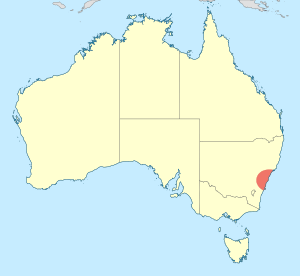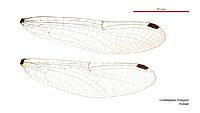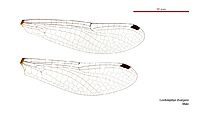Clubbed shutwing facts for kids
Quick facts for kids Clubbed shutwing |
|
|---|---|
| Conservation status | |
| Scientific classification | |
 |
The clubbed shutwing (scientific name: Cordulephya divergens) is a special type of dragonfly. It belongs to the family Cordulephyidae. This small insect is found only in Australia. It lives near streams in the Sydney Basin area.
Dragonflies are amazing insects known for their bright colors and fast flying. The clubbed shutwing is unique because it rests with its wings folded. Most dragonflies rest with their wings spread out flat. But the clubbed shutwing folds its wings above its body, much like a damselfly does. This makes it stand out from other dragonflies.
Contents
What is a Clubbed Shutwing?
The clubbed shutwing is a very small dragonfly. It usually has a black or purplish-black body. You might also see yellowish marks on its body. These markings help it blend in with its surroundings. It was first described in 1917 by a scientist named Robert John Tillyard.
Where Does it Live?
This unique dragonfly calls the Sydney Basin home. This area is in Australia. It prefers to live near clean, flowing streams. These streams provide the perfect place for it to hunt and lay its eggs. Keeping these streams healthy is important for the clubbed shutwing's survival.
Why is it Called "Clubbed Shutwing"?
The name "clubbed shutwing" comes from two main features. "Shutwing" refers to how it folds its wings when resting. This is different from most dragonflies. The "clubbed" part might refer to the shape of its body or parts of its wings. Dragonflies often get their common names from their unique looks or behaviors.
Life Cycle of a Dragonfly
Like all dragonflies, the clubbed shutwing goes through several stages in its life. This is called metamorphosis. It starts as an egg, then becomes a nymph, and finally an adult dragonfly.
Eggs and Nymphs
Female clubbed shutwings lay their eggs in or near water. Once the eggs hatch, tiny creatures called nymphs emerge. These nymphs live underwater. They are fierce predators, hunting small aquatic insects and even tiny fish. Nymphs can spend months or even years underwater. They grow by shedding their skin many times.
Becoming an Adult Dragonfly
When a nymph is ready, it crawls out of the water. It usually climbs onto a plant stem or a rock. Then, its skin splits open. The adult dragonfly slowly emerges. Its wings are soft at first. They harden as blood pumps into them. Once its wings are strong, the adult dragonfly takes its first flight. Adult clubbed shutwings spend their time flying and hunting near streams. They catch other insects in the air.
Conservation Status
The clubbed shutwing is currently listed as "Vulnerable" (VU) by the IUCN. This means its population is facing a high risk of becoming endangered in the wild.
Why is it Vulnerable?
The main reasons for its vulnerable status are often related to its habitat. Pollution of streams and rivers can harm the nymphs. Changes to the land around streams, like building or farming, can also destroy their homes. Protecting the streams in the Sydney Basin is key to helping the clubbed shutwing survive. Conservation efforts aim to keep its habitat clean and safe.
Gallery




